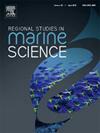连云港近海海水、表层沉积物和海洋生物中重金属的分布及污染评价
IF 2.1
4区 环境科学与生态学
Q3 ECOLOGY
引用次数: 0
摘要
人类活动引起的重金属污染已引起人们的广泛关注,并可能导致严重的环境问题。采用多指标分析了连云港近海表层沉积物、海水和海洋生物中重金属的空间分布和污染状况。结果表明,海水和沉积物中重金属均符合一级水质标准(GB 3097-1997)和海洋沉积物质量标准(GB 18668-2002)。海水中重金属处于清洁状态,潜在生态风险较低。沉积物中重金属的空间分布主要受平均粒径控制,大部分站点的潜在生态风险较低。汞和镉的存在由于其强烈的生物毒性而构成重大的生态风险。虽然海水中重金属的浓度往往很低,但海水中的污染物可以通过食物链逐步集中到较高层次的生物体中。大多数重金属的BWAF值均超过1,表明该生物具有显著的海水富集能力。因此,有必要保护海水的质量,特别是考虑到它对海鲜消费的潜在影响。本文章由计算机程序翻译,如有差异,请以英文原文为准。
Distribution and pollution assessment of heavy metals in seawater, surface sediments and marine organisms in Lianyungang offshore, China
The heavy metal pollution due to human activities has attracted considerable attention and may lead to serious environmental problems. Multiple indices were used to analyze the spatial distribution and pollution status of heavy metals in surface sediments, seawater and marine organisms in Lianyungang offshore. The results showed that the quality of all heavy metals in seawater and sediments complied with the first-class water quality standard (GB 3097–1997) and marine sediment quality standard (GB 18668–2002). Heavy metals in the seawater were in a clean state and at a low potential ecological risk. Spatial distribution of heavy metals in the sediments was mainly controlled by mean grain size and most of the stations were at a low potential ecological risk. The presence of mercury and cadmium represents a significant ecological risk due to their strong biological toxicity. Although the concentration of heavy metals in seawater is often very low, but the pollutants in the seawater can be concentrated step by step in the higher level of organisms through the food chain. The majority of heavy metals exhibited a BWAF value exceeding 1, indicating that the organisms possess a notable capacity for enrichment from seawater. Therefore, it’s necessary to safeguard the quality of seawater, particularly in light of its potential impact on seafood consumption.
求助全文
通过发布文献求助,成功后即可免费获取论文全文。
去求助
来源期刊

Regional Studies in Marine Science
Agricultural and Biological Sciences-Ecology, Evolution, Behavior and Systematics
CiteScore
3.90
自引率
4.80%
发文量
336
审稿时长
69 days
期刊介绍:
REGIONAL STUDIES IN MARINE SCIENCE will publish scientifically sound papers on regional aspects of maritime and marine resources in estuaries, coastal zones, continental shelf, the seas and oceans.
 求助内容:
求助内容: 应助结果提醒方式:
应助结果提醒方式:


